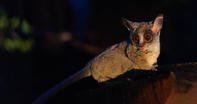
Name
Lesser Bushbaby (galago moholi)Lesser Bushbaby Appearance
Lesser bushbabies have rounded fingernails, except for the second toe which is used as a grooming claw to comb the head and neck fur, and to clean the ears. It has a tooth comb dental structure which also facilitates grooming.
Its toes and fingers are padded with flat disks of thickened skin, providing grip in climbing trees and on slippery surfaces. The index finger on each paw is much shorter than the others, allowing a better grip on bigger branches.
The coat of the lesser bushbaby varies from a brownish grey to a light brown. Its limbs and sides have a distinctly yellow hue, with a marking between the dark ringed eyes.
Lesser Bushbaby Diet
The lesser bushbaby licks dew and rainwater from cracks and crevices, and eats insects and tree gum.Lesser Bushbaby Breeding
Lesser bushbabies generally give birth to twins after a 125 day gestation period, immediately followed by another oestrus cycle. They give birth before the rainy season, and well before the next dry season the next set of twins are born.
At the peak of her oestrus cycle, a lesser bushbaby female will mate with up to six males. She will build nests for her infants to stay in while searching for food, and protect them from danger by carrying them away in her mouth. Male lesser bushbabies mark the females by urinating on them.
Lesser Bushbaby Behaviour
The lesser bushbaby is a small, nocturnal, tree-dwelling primate. They can make huge leaps between trees, but at times walk on the ground using all fours or their hind legs. Adult males avoid conflict and confrontation with one another by protecting their individual territories.
Apart from this behavioural characteristic, their social systems and habits are similar to that of the thick-tailed bushbaby. Adults forage unaccompanied, but at night gather to interact and during the day to sleep in groups of six.
The lesser bushbaby has about 18 different calls which can identify different behaviours. Their calls communicate social contact, aggression and defensiveness, and is a vital survival strategy in recognising and warning of the enemy.
Their hearing is highly developed, and their ears have intricate folds which allows them to locate the source of the sound accurately. The lesser bushbaby can hear the glide of an owl. Their eyes are unable to move in their sockets, making their heads move constantly in search of prey.
With extremely quick movements, they can catch moths and grasshoppers in the air with their front paws while gripping onto a branch with their hind legs. Before embarking on a night’s foraging expedition the lesser bushbaby will groom itself, being very particular of its appearance.
Lesser Bushbaby Habitat
Being a South African species, the lesser bushbaby has a high tolerance of temperature variation. It prefers savannas, woodlands, the fringes of the forest and riverine bush as its habitat, and in particular near the Limpopo River where the Marico and Notwani Rivers meet.Where they are found
The lesser bushbaby ranges throughout the Southern African Region including South Africa, Namibia, Botswana, Mozambique, and Zimbabwe - as well as in Swaziland.
Lesser Bushbaby Predators The lesser bushbaby has many predators, including larger species of owl, servals, snakes, African wild cats, and genets. However, their greatest threat is fire. Despite its ability to leap between trees, the lesser bushbaby is incapable of moving large distances at a time.
They are therefore greatly affected if a fire destroys the food supply of their inhabited area. They are usually found in habitats of short and moist grass - a form of protection from fire.
 Being a South African species, the lesser bushbaby has a high tolerance of temperature variation. It prefers savannas, woodlands, the fringe...
Being a South African species, the lesser bushbaby has a high tolerance of temperature variation. It prefers savannas, woodlands, the fringe...